 |
| |
    
|
| |
      
|
|
EARLY
HISTORY
(1865
- 1928)
|
|
| |
A DAY AT THE RACES
The Downs close to
Epsom have always been one of the green lungs of the
greater London area and even became something of a spa
with the discovery of Epsom Salts in 1618. The
popularity of Epsom Spring Water lasted for a couple of
decades until it
gradually went out of fashion and the old well was locked
up in 1727 (Pownall, 1825).
But even with a regular stream of weekend ramblers from
the city, the Downs basically remained a nice place out
in the middle of nowhere - and the sole reason to build a
railway line terminus there was horse racing.
"There can be no
doubt, that Epsom Downs (or as they are frequently,
though erroneously written in old writings, Banstead
Downs) early became the spot, upon which the lovers
of racing induldged in their fancy. And, perhaps, the
known partiality of King James I., for this species
of diversion, will justify us in ascribing their
commencement to the period when he resided at the
palace of Nonsuch (...) When the races on Epsom Downs
were first held periodically, we have not been able
to trace with accuracy." (Pownall, 1825)
The first recorded
race was held on the Downs in 1661, but ad hoc
races both for runners and horses had taken place long
before that date - sometimes even to cover up yet other
reasons for the gathering of men and horses:
"Soon after the
meeting, which was held at Guildford, 18th May 1648
(...) a meeting of the royalists was held on Banstead
Downs under the pretence of a horse race, and six
hundred horses were collected and marched to
Reigate." (Clarendon, 1704)
Organised
racing was held on a regular basis and was so popular
that it found its way into the diaries of Samuel Pepys on
three occasions in 1663.
"This day there was great
thronging to Banstead Downs, upon a great horse-race
and foot-race. I am sorry I could not go
thither." (Samuel Pepys' Diary, 27th May 1663)
"Having intended this day to go to
Banstead Downs to see a famous race, I sent Will to
get himself ready to go with me (...) and so by boat
to White Hall, where I hear that the race is put off,
because the Lords do sit in Parliament to-day." (Samuel Pepys'
Diary, 25th July 1663)
"The town talk this day is of
nothing but the great foot-race run this day on
Banstead Downes, between Lee, the Duke of
Richmond’s footman, and a tyler, a famous
runner. And Lee hath beat him; though the King and
Duke of York and all men almost did bet three or four
to one upon the tyler’s head." (Samuel Pepys'
Diary, 30th July 1663)
On the 4th of May
1780 Edward Smith-Stanley, 12th Earl of Derby organised a
race for himself and his friends which he named The
Oaks after his estate. The event - the first
"Derby" - met with instant success, and in 1784
the course was extended to its current distance of a mile
and a half, and Tattenham Corner was introduced.
Even in the days
when no form of public transport was available, flocks of
people from all over South-East England would come
together on Epsom Downs to attend the races - in the
1820s, crowds of up to 80,000 were reported by the
newspapers.
|
| |
|
It is
therefore hardly surprising that right from the
beginning of the railway age in the South East,
horse racing events were seen as an important
market segment.
The London & Southampton
Railway, for example, opened its line between
Nine Elms and Woking earlier than planned in May
1838 and arranged for unscheduled train stops at
a location close to where Surbiton station now
stands. The result was dramatic: 5,000 people
tried to get a seat at Nine Elms on "Derby
Day" (Kirkby, 1983), and by the mid-19th
century, attendance at the Derby was around
500,000, including the Royal Family and members
of Parliament (Stanley, 1956).
THE BANSTEAD
& EPSOM DOWNS RAILWAY
Race
traffic continued to grow accordingly, and thus a
group of local businessmen got together and
formed a company known as the Banstead &
Epsom Downs Railway, for which they applied to
Parliament and duly received authority on 17th
July 1862.
The
act, totalling 56 paragraphs on 18 pages, not
only dealt with standard questions in conjunction
with the building of a new railway line but was
also set out to safeguard third party interests.
Primarily,
this concerned the London Brighton & South
Coast Railway which had every intention of
keeping its controlling power at Sutton station
(now to become a junction), but it also concerned
the trustees of the Ewell to Burgh Heath
turnpike, which the railway planned to cross by
means of a bridge, for which detailed building
conditions and instructions were set up.
And
finally, due to fierce opposition of both the
Lord of the Manor of Epsom Downs and the Epsom
Grandstand Association, the original plans to
build the station as close as 220 yards to the
Grandstand had to be revised and the station
built some 1,100 yards away from the Grandstand.
And
so, what is today the Epsom Downs Branch was born
out of one reason only: horse-racing.
It
was the time of short railway line proposals all
over England, a large part of which found
themselves in some kind of trouble almost right
after their Bill had been passed - and the
Banstead & Epsom Downs Railway Company fared
no better as it tried hard to raise its capital
of £85,000 (the approximate equivalent of
£9,350,000 today) through 8,500 shares at a
nominal value of £10 each.
|
|
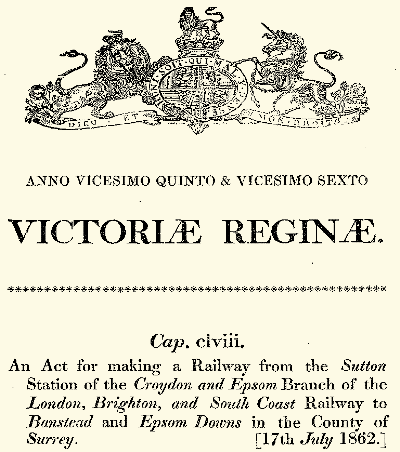
The
complete act - scanned from an original print in
my personal collection - can be downloaded as a pdf file
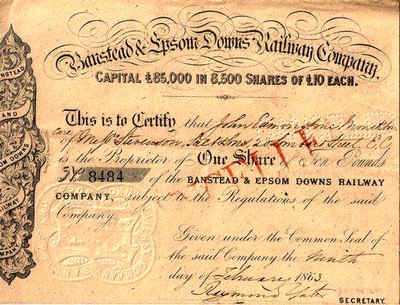
(Ian Dinmore /
railarchive.org.uk, used with kind
permission)
|
|
| |
CONSTRUCTION OF THE LINE
UNDER LB&SCR MANAGEMENT
Mounting
disagreement amongst the local leaders of the project
resulted in the forming of bitter factions and finally
brought about negotiations on the disposal of the
contracts which led to a transfer of management into the
hands of the London Brighton & South Coast Railway in
March 1863 (Kirkby, 1983).
In June
1864, the Banstead & Epsom Downs Railway Company was
amalgamated into the LB&SCR. The railway finally
opened to traffic on 22nd May 1865, and
transported some 70,000 people during the races of that
week (Kirkby, 1983).
|
| |
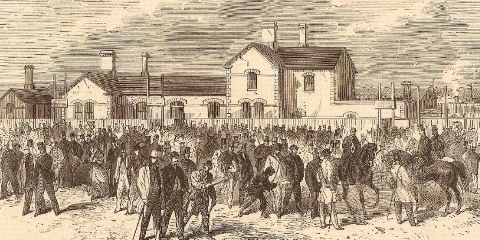
"THE
NEW RAILWAY STATION AT THE RACE-COURSE, EPSOM
DOWNS."
(Illustrated
London News
Supplement,
3 June 1865) (personal collection)
|
|
The newly
built line was also reported on in the papers,
and the Illustrated
London News Supplement devoted half a page
to an illustration of Epsom Downs station in its
edition of 3rd June 1865.
The now famous
Bradshaw's Handbook for
Tourists in Great Britain and Ireland (better
known as Bradshaw's Railway Handbook),
published in 1866, mentioned the then brand new
line briefly:
"A short line of railway
runs hence [from Sutton] by California [i.e.
Belmont], across Banstead Dozens, a range of
hills commanding some very pretty and
extensive scenery, at the foot of which is
the station of Banstead. It extends to Epsom
Downs, in the immediate neighbourhood of the
Race Course."
|
|
| |
| In order to accomodate the huge
amount of race traffic on Derby Days, the line was double
track right from the beginning of the first planning
stages, with its starting point being the railway line
and station at Sutton. Epsom Downs station was originally a large and
complex affair, as can be glimpsed from this picture
taken on Derby Day in 1907. On the extreme left, the
Royal Train can be seen, and the number of signals and
engine release roads (with earth mounds acting as
bufferstops) is quite impressive. |
| |
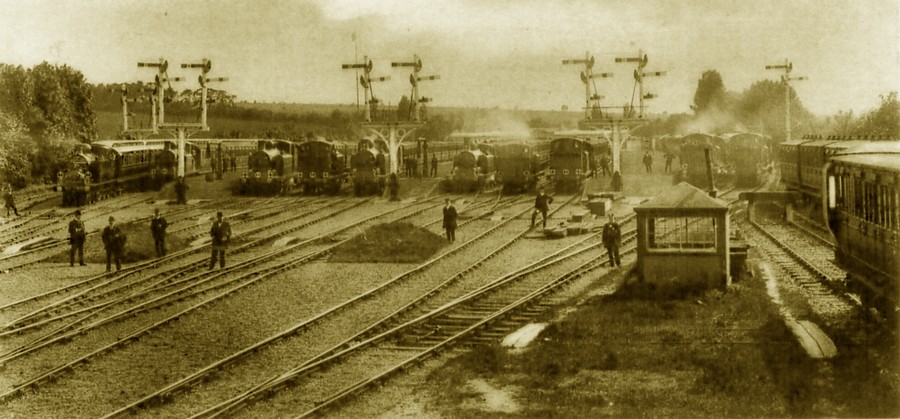
(Lens of Sutton)
|
| |
| Sutton station had been opened
by the LB&SCR in 1847 as part of the Epsom extension
of the London Bridge to West Croydon line (opened in
1839) and was, in 1865, a simple through station with two
platforms. Construction of the Epsom Downs branch turned
Sutton into a junction, with its double track turning
South immediately. |
| |
| Whereas the
Epsom line platforms (1 & 2) at Sutton were
straight, the branch platforms (3 & 4) were
(and still are) sharply curved. The entrance to
the station buildings, which were mainly located
in the triangle formed by the two lines, was at
street level, with passengers having to descend
stairs to get to the platforms below. In 1891 proposals were put forward in
connection with the question as to how Tadworth
(a fast growing and popular high-class
residential area since the 1880s) should be
connected to the railway system. A local interest
group obtained an act in 1892 for the proposed
"Epsom Downs Extension Railway" (the
line would have run off the Epsom Downs branch
near Banstead to climb southwards to Tadworth),
but these plans were immediately faced with huge
problems due to insufficient capital and a
distinct lack of interest shown by the LB&SCR
(Kirkby, 1983).
|
|
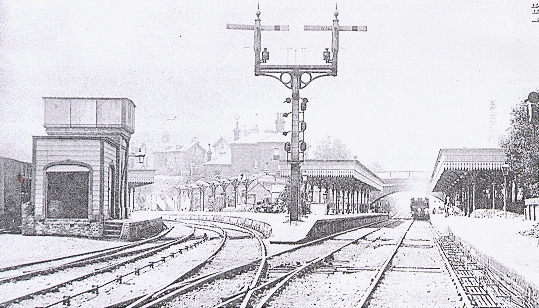
Sutton
Station in 1867; the branch to Epsom Downs curves
away to the left (Lens
of Sutton)
|
|
| |
| The Chipstead Valley
Railway (an act for which was obtained in 1893) planned a
railway from a junction wiht the LB&SCR mainline at
Purley and intended to connect with the proposed Epsom
Downs Extension Railway, thus creating a through line
between Purley and Sutton. Eventually, the line was built
from Purley to Kingswood in 1897 by the South Eastern
Railway, and finally completed to Tadworth and Tattenham
Corner in 1901 (Kirkby,
1983). The Epsom
Downs Extension Railway never materialized, but oddly
enough, Surrey County Council was required to pronounce
itself in 1997 on suggestions that a rail link should be
built between Tattenham Corner and Epsom Downs stations
to create a loop line and shorten journey times. These
plans, however, were dismissed on the grounds that
construction costs would have been prohibitive in such a
densely populated area. |
| |
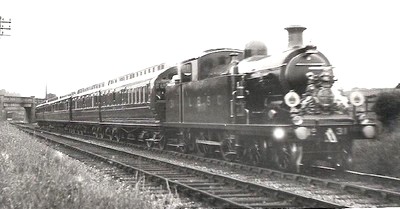
Having left
Victoria Station at 12.40, the Royal Train has
just passed Belmont on 4th June 1913 (personal
collection)
|
|
Epsom Downs
station became a part of Britain's social history
when militant suffragette Mary Richardson was
beaten and subsequently chased to the station by
an angry crowdon 4th June
1913. Before that incident, Emily
Wilding Davison, who had accompanied Richardson,
had stepped out in front of the King's horse
during the Derby race.
Davison
subsequently died from her injuries, while
Richardson was given refuge for several hours at
the station by a porter (Atkinson, 2005).
On 1st January 1923, the Epsom Downs
branch together with the LB&SCR became, by
act of Parliament, part of the Southern Railway -
an event which proved quite decisive with respect
to the electrification of the line.
|
|
| |
| Whilst the
LB&SCR had started building up a 6700 volts
A.C. overhead electric system on its lines since
1909 (overhead wires services were actually taken
up between Victoria and Sutton via West Croydon
in April 1925 [Kirkby, 1983]), the Southern
eventually opted for the now well-known third
rail system using 750 volts D.C. On 17th June 1928 the third rail
electrification was completed to Epsom Downs -
the last regular steam train on the line left
Epsom Downs on that very same day. The last Royal
train had run to Epsom Downs four years before,
in 1924, after which date the Royals went by
road. Returning to rail travel after the end of
WWII, the choice fell on Tattenham Corner, which
had been opened in 1901 and was more conveniently
situated, i.e. closer to the Grandstand (Kirkby,
1983).
The
now redundant turntable at Epsom Downs was
removed in February 1931 (Kirkby, 1983).
|
|

Built to
handle masses of trains and people on a few
racing days a year, the terminus at Epsom Downs
saw little traffic on regular working days - a
contrast visible in this 1928 scene (with the
conductor rail for electric propulsion already in
place) (R.C. Riley Collection)
|
|
| |
| Epsom Downs had lost much of
its glamour on derby days, in spite of continuing to
welcome masses of spectators to its multiple platforms.
The coming of the electric trains, however, heralded a
new age - and a fundamental change to the character of
the Epsom Downs branch. |
| |
|
| |
BIBLIOGRAPHY
ATKINSON Diane
(2005) "Deeds not words", in New Statesman,
6 June 2005
CLARENDON
Edward Hyde, 1st Earl of (1704) The History of
the Rebellion and Civil Wars in England Begun in the Year
1641, Oxford University Press (1992)
KIRKBY
J.R.W. Kirkby (1983) The Banstead and Epsom Downs
Railway, Locomotion Papers Series, Oakwood Press
POWNALL
Henry (1825) Some particulars relating to the history
of Epsom,
compiled
from the best authorities; containing a description of
the origin of horse racing, and of Epsom races, with an
account of the mineral waters, and the two celebrated
palaces of Durdans and Nonsuch, &c., &c, W.
Dorling Printers, Epsom
STANLEY Louis
T. (1956) London Season, Riverside Press
|
| |
|
| |
Continue to Southern Electrics: 1928 -
1986
Return to main index
|
| |
|
| |
Page
last revised 22 July 2024
|
| |

|







